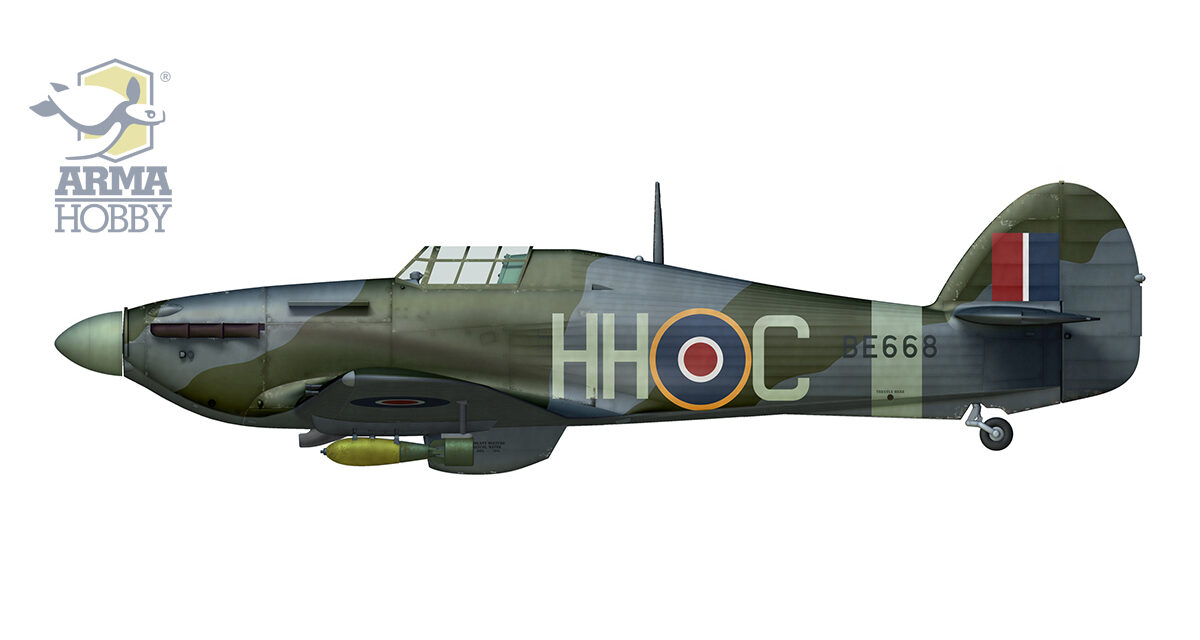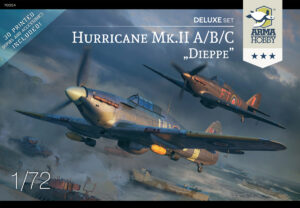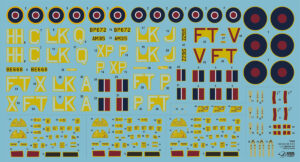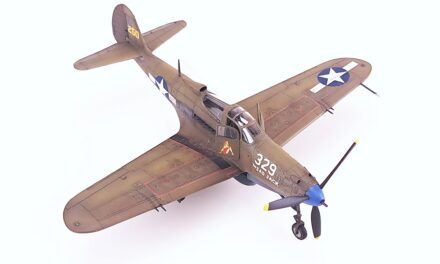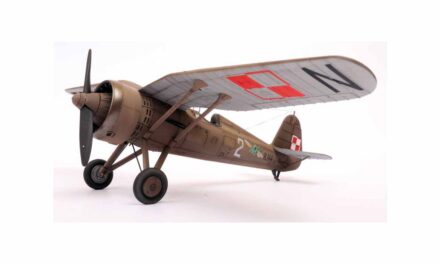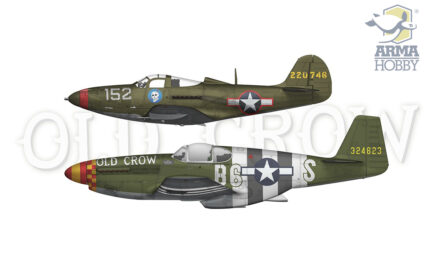This year marks the 80th anniversary of Operation Jubilee, which took place on 19 August 1942. The landing on the beaches of Dieppe was in itself a severe military defeat, with the Allied forces suffering heavy losses, but the conclusions drawn from this logistically complicated operation, in which different branches of service worked together, made it possible to better prepare for the assaults on Sicily, the Apennine Peninsula, and – finally – Normandy. Hurricane squadrons participated in it in large numbers, drawing to a close the type’s rich combat history in the European Theatre of Operations.
At Dieppe, the Hurricane was used as a battlefield aircraft, tasked with destroying enemy fire points and artillery positions located on the wings and in the immediate vicinity of the German front line. In fact, only two of the Hurribomber squadrons had the training and armament required for the mission. Most of the other units had been operating in the night-fighter and intruder role for quite some time before the raid, and it was not uncommon for their “preparations” to consist in a single training flight (during which they were hurriedly taught how to fire at ground targets) and changing the camouflage from black to one more suited to day flying.

Dieppe – landing site. 1945 photo. Source: U.S. National Archives and Records Administration/Public Domain
It is not my intention to copy the literature discussing Dieppe. I will focus on providing a general outline and analyse some interesting aspects of the Hurricanes’ involvement in Operation Jubilee, and also talk over the painting instructions, which cover eight Hurricanes from four squadrons: Nos. 43, 87, 174 and 175. The ambition to develop paint schemes for Hurricanes from all eight RAF units that took part in the assault could not be fulfilled due to a prosaic reason, namely the complete lack of photographic materials for Nos. 3, 32, 245 and 253 Squadrons RAF from the period in question. In the first edition of the Mk.IIb model, we presented BE682/XP-R “Mauritius VII”, which also took part in the operation.
Thus, our offering will comprise a total of nine participating aeroplanes in four different versions: Mk.IIa, IIb, IIc and the Canadian-made Mk.X (following conversion to the Mk.IIb standard, with which it was essentially identical). No. 87 Squadron also used three Mk.Ia, and this was probably the version’s last combat action over France. I do hope that one day this version will also appear in Arma Hobby’s product catalogue, increasing our collection of “Dieppe Hurricanes” to ten.
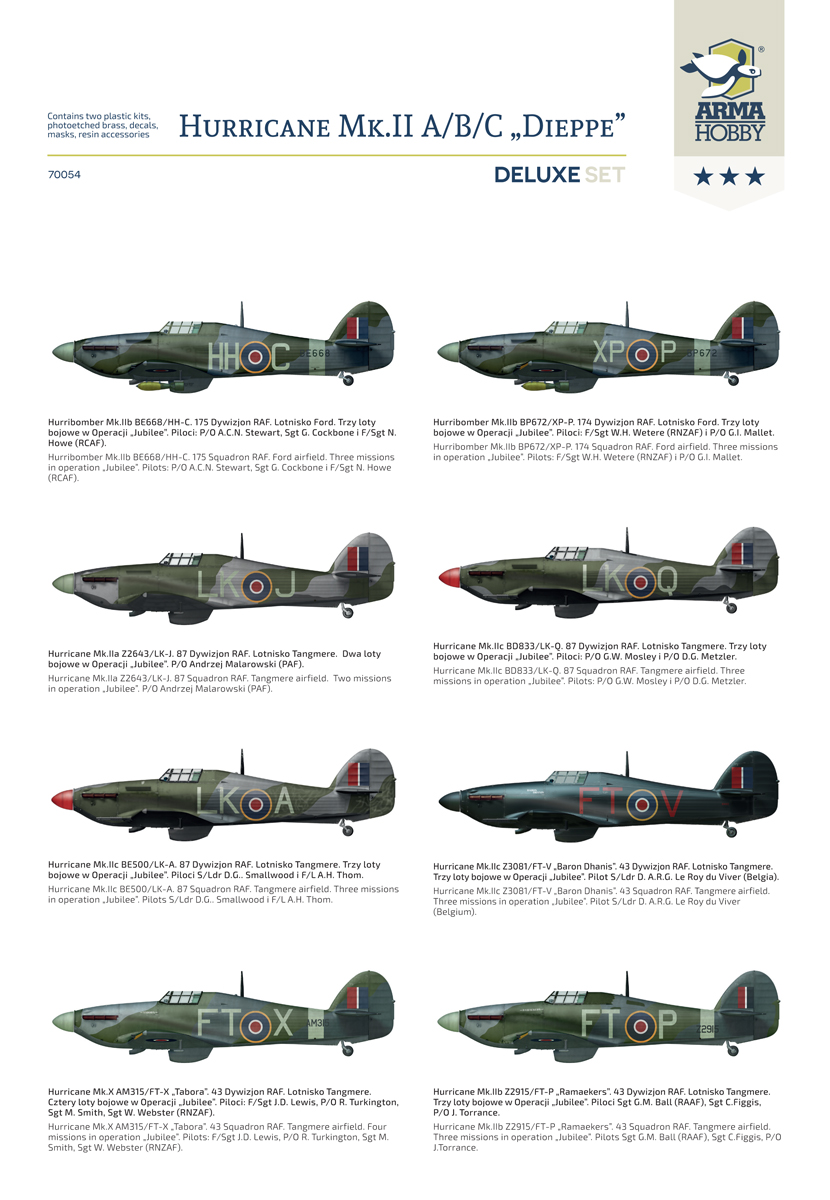
Ocean of greys
Where did the idea for such a set come from (aside from wanting to celebrate Operation Jubilee)? It is commonly considered that Hurricanes in the Day Fighter Scheme are boring, repetitive, and do not catch the eye. After browsing the resources of the Imperial War Museum, wherein I found films shot on 19 August 1942 at Tangmere and Ford airfields, I can only say that this opinion is far removed from the truth. The recordings show a completely different picture. There is no boredom and no monotony, and almost every aeroplane is different, each with a unique character and feel. In a few instances, the aircraft are shown from both sides, which has helped greatly improve the historical accuracy of our reconstructions. At the same time, the existence of an excess of information that does not match a fixed pattern makes everything a bit more difficult, particularly as it cannot be readily translated into a paint scheme comprehensible to modellers. Needless to say, the schemes are a simplification, and have to be approached as a point of departure, which individual model-makers can improve in accordance with my tips and the conclusions that they themselves will draw from a careful study of the videos and photos.
The first two silhouettes, of Hurribombers from Nos. 174 and 175 Squadrons RAF Hurribombers taking off from Ford airfield, are the most classic.
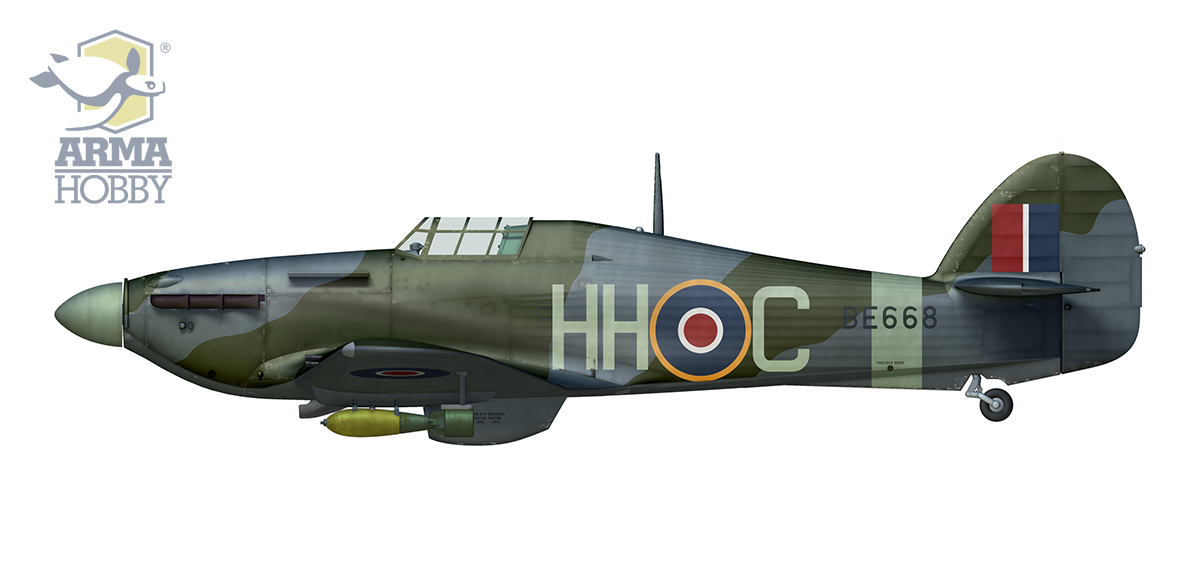
Incidentally, there is an interesting and pleasant event connected with BE668/HH-C from No. 175 Squadron RAF. I was able to get in touch with the children of one of the Canadian pilots, F/Sgt Norman Howe, who helped me greatly by sending a copy of their father’s log book and a set of photographs, which allowed me to confirm the serial number and recreate the exact appearance of the aeroplane (presented on the boxart and the first illustration). Peter and Robin Howe and their sister Louise were very touched when I sent them a copy of the Imperial War Museum’s film showing Hurricane BE668 – with their father at the controls – landing at Ford. Most unfortunately, the aircraft from this unit are not well documented in the photographs. While there are a few images from the spring of 1942, there are none from the summer, and thus the film was the sole material upon which we based our work: https://www.iwm.org.uk/collections/item/object/1060021074 from 7:11
Heavy bombs
The aircraft used in Operation Jubilee were armed with bombs weighing 250 and 500 lb. The initial missions were flown with bombs weighing 500 pounds, but already after the first it was decided that, in the specific conditions of Dieppe, lighter bombs would be more effective – and safer for the pilots. Due to the low-lying cloud ceiling, pilots were forced to launch their attacks from lower altitudes. With manoeuvrability being limited by carrying a total of 1,000 pounds of bombs, hitting the target became an extremely difficult task. In addition, the time fuses were not very reliable, and this posed the danger of an exploding bomb damaging a low-flying attacker, or another aeroplane that may have been flying too low. P/O Derek Stevenson, the author of the memoiristic “Six Crashes Later”, wrote that pilots were relieved to hear that the Hurribombers would be armed with 250 lb bombs for the second attack.
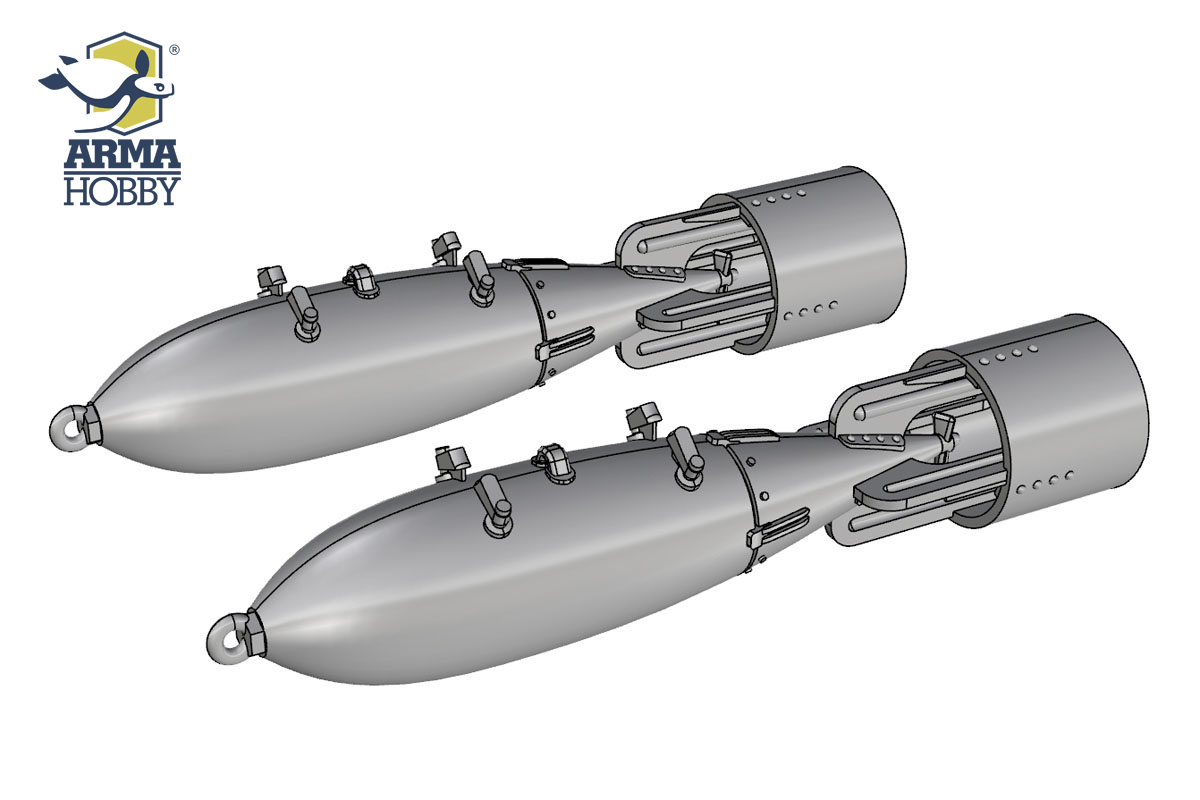
British 500 lb bombs. Rendering of the 3D prints included in the model kit
It could be argued that P/O Stevenson was out of luck that day. He survived, but the path to survival was by no means simple. While taxiing to take off for the first assault, still before sunrise, he caused a collision with the aeroplane directly in front of him, while another Hurribomber crashed into his tail, slashing it with its propeller. The final, fourth, aircraft also failed to brake in time, and, as a result, the squadron took off late, with only eight fighters, and in a dispersed formation. P/O Stevenson’s next mission was the last flown that day, in the afternoon. At the controls of BE687/HH-A, he was duly shot down by anti-aircraft artillery. After jumping with his parachute into the Channel, he was picked up by Polish sailors from the destroyer ORP Ślązak and reached Portsmouth in the evening, accompanied by nearly a hundred, mostly wounded Canadians who had been evacuated by the vessel. P/O Stevenson is the person missing from the film showing the three landing Hurribombers. The event was also mentioned by F/Sgt N. Howe in his log book. A good illustration of the realities of service is that the very next day after these adventures P/O Stevenson was placed the controls of another Hurricane (BE668). He recalled that a quick return to normal operations after even the worst experiences was considered advisable in order for pilots to maintain their mental balance.
But that day – the pre-flight collision notwithstanding – No. 175 Squadron RAF was the happiest of all the Hurricane units. Over the course of three missions, its airmen had completed a total of 27 missions. All the pilots eventually returned safe and sound, and only Stevenson’s aeroplane was lost. Sgt J. Jackson, on BE503/HH-H, made a forced landing in random terrain, while Sgt D. S. Conroy’s fighter suffered minor damage. Two pilots claimed aerial victories: F/Sgt J. E. Meredith reported one confirmed (a Heinkel He 111), and P/O R. A. Peters one probable and one damaged (both Focke-Wulf Fw-190s).
Frenchmen in the British squadron
BP672/XP-P from No. 174 Squadron RAF carries the equally classic Day Fighter Scheme. It can be seen in two Imperial War Museum films: ARY 17-12, starting from time 05:58: https://film.iwmcollections.org.uk/record/998
and ARY 17-13 from 09:15: https://film.iwmcollections.org.uk/record/2009
The film was made a few weeks before the attack on Dieppe, during Operation Rutter.
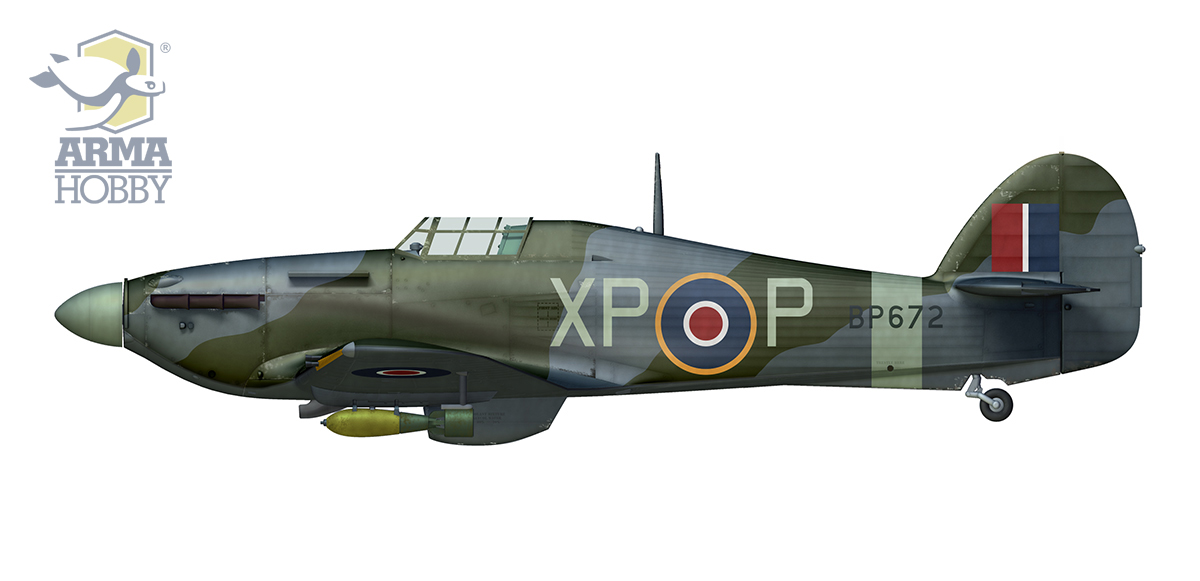
This was a somewhat newer aeroplane, from a later production batch. It was equipped a full battery of 12 machine guns (like other Hurribombers from the batch, BE668 had the muzzle of its second machine gun – counting from the fuselage – blanked off). Before the BP series was approved for manufacture, designers had to resolve the problem of the spent casing ejector being covered by the bomb catch. Ultimately, the aerodynamic shield of the bomb release gear was provided with a channel through which casings were removed to the outside.
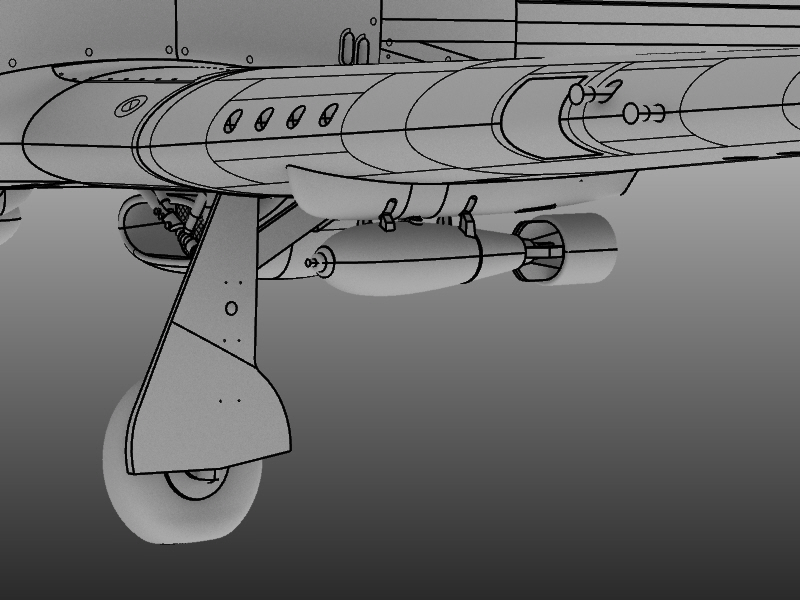
British 250 lb bomb under the Hurricane Mk.IIb. 3D rendering of the Arma Hobby model kit
As in No. 175 Squadron RAF, use was made of both bomb types. The unit’s Intelligence Officer noted that thirty-six 500 lb bombs and thirty 250 lb bombs were dropped that day. In the third and final mission, only the lighter bombs were used.
The squadron left for its first attack well before dawn, at 04:40, so as to fly in over Dieppe when the initial wave of Canadian troops landed. Problems were encountered, however: several dozen aircraft from different units were departing Ford simultaneously, and, in the darkness, No. 175 Squadron RAF was unable to group in formation after take-off. In fact, one of the pilots failed to join any section at all. The mission was the first during which the unit was led by its new commander, the French S/Ldr François Émile Fayolle, who had been appointed only three weeks before.
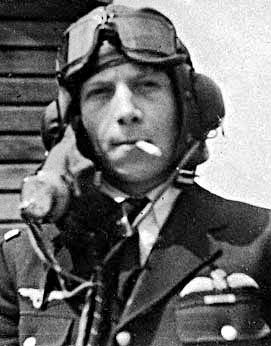
S/Ldr François Émile Fayolle
Tragically, during his first operational flight as Squadron Leader, he perished in circumstances that have not been fully explained to date. Piloting HV557, he could have been shot down by a lone FW-190 – which other airmen saw flying along the return route – or crashed into the sea after being hit by flak near the target. He was one of the three commanders of RAF squadrons killed that day. No. Squadron RAF lost S/Ldr A. E. Berry (RNZAF), and No. 41 Squadron RAF S/Ldr L. G. C. Hyde. Fayolle was buried at Hautot-sur-Mer cemetery west of Dieppe, alongside the two other Squadron Leaders.
The second mission was even more disastrous. Of the twelve Hurribombers which departed Ford airfield at 10:25, only nine returned. Sgt James C. Frederick, flying on BE649, perished. F/Lt Raymond van Wymeersch (BP299/XP-U) and F/Sgt Charles B. Watson (BE505/XP-L) were shot down over the target but managed to parachute safely and were taken prisoner. IWM CH 5636
For its final mission, the depleted squadron had only 10 aircraft available – and quickly suffered another loss. Fate was again cruel to the Free French: P/O Maurice Halna du Fretay, a 22-year-old nobleman from Brittany and a Chevalier of the French Legion of Merit, who became famous after escaping to England on 15 November 1940 on his private Zlin Z-XII sports aeroplane, perished while flying on HL705.
In total, they flew 34 missions, losing 5 aircraft and their pilots. No. 174 Squadron RAF incurred the heaviest losses of all the Hurricane units.
See also:
- Check Hurricane Mk IIA/B/C “Dieppe” Deluxe Set and more in the Arma Hobby webstore
Model maker for 45 years, now rather a theoretician, collector and conceptual modeller. Brought up on Matchbox kits and reading "303 Squadron" book. An admirer of the works of Roy Huxley and Sydney Camm.
This post is also available in:
 polski
polski


